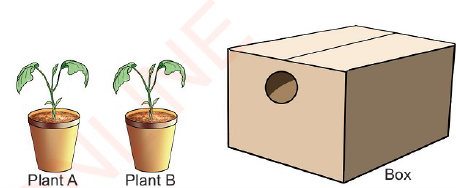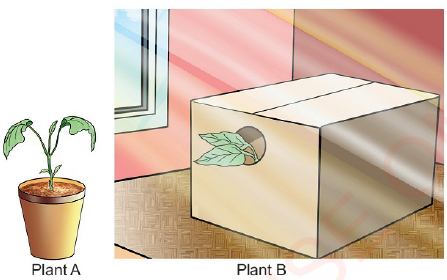Chapter 01 : Living things
Introduction
Creatures that possess life are collectively called living things. They are characterized by the ability to grow, take nutrients, reproduce, respire and being sensitive to the environment in which they live. In this chapter, you will leam about the characteristics of living things and how to classify them. You will also learn about the habitats and common characteristics of each group. Lastly, you will investigate living things in their natural environment and communicate the findings.
Characteristics of living things
There are seven characteristics that differentiate living things from nonliving things. They are presented below.
(i) Nutrition
Nutrition means the process by which living things obtain and use food for growth, metabolism and repair. Living things need nutrients, which are obtained from the environment in the form of food. Food provides living things with important nutrients such as protein, carbohydrates, fats, minerals and vitamins.
(ii) Respiration
Respiration is the burning of food substances by oxygen to release energy in the body of a living thing. It involves exchanging two gases, namely oxygen and carbon dioxide. Animals inhale oxygen and exhale carbon dioxide.
(iii) Sensitivity or irritability
Living things sense and respond to stimuli in their environment. A stimulus is anything that can evoke a response in a living thing. The ability of living things to detect and respond to stimuli in their environment is called sensitivity or irritability. Examples of stimuli are light, temperature and water. Animals detect stimuli by using sense organs such as the nose, skin, eyes, tongue and ears. Plants respond to stimuli using roots, the stem, branches and flowers.
(iv) Movement
All living things move. Animal movement is usually visible. Movement in plants involves only certain parts, and not the whole plant. Movement in plants is mainly through the bending, twisting and elongation of certain parts of a plant or its organs. The movement of plants is very slow and therefore difficult to see.
(v) Reproduction
All living things can produce young ones which resemble them. Animals may reproduce through various ways, including laying eggs or giving birth. Plants reproduce using seeds and can reproduce through other means, including cuttings from stems or roots from mature plants. All living things are products of reproduction. Reproduction is important for the continuity of generations. Without reproduction organisms would disappear.
(vi) Excretion
All living things excrete waste materials from their bodies. Excretion means getting rid of waste products. In animals excretion is carried out by kidneys, lungs and skin. Excretory materials get out of the body in the form of urine or sweat. Plants do not have special organs for excretion. Plants excrete waste products in the form of water vapour, gases, gums, oils, latex and resins.
(vii) Growth
Growth is the physical increase in the size, height and weight of a living thing. It is one of the characteristics of all living things which occurs either by an increase in size or by multiplication. It is usually an irreversible process. Every sexually reproducing living organism begins life as a single cell before it starts to grow.
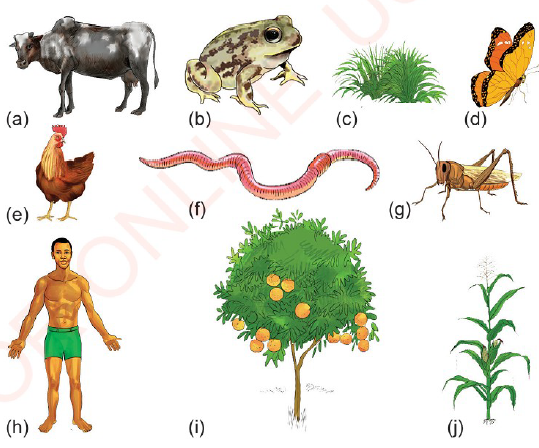 Figure 01 Examples Of Living Things |
| Exercise 1 Answer the following questions. 1 . Write the names of the living things shown in Figure 1 . 2. Classify the living things in Figure 1 either into animals or plants. 3. Explain two differences between plants and animals in terms of their characteristics. 4. Explain the importance of movement to living organisms. 5. List the excretory products produced by plants. |
| Experiment 1: Movement of plants towards light |
| Aim: To investigate how parts of plants move towards light Materials: (i) Two small healthy potted plants called A and B (ii) A box with a small hole on one side
Figure 2: Potted plants A and B and a box with a small hole Procedure 1 . Label 2 potted plants as A and B before the experiment. 2. Water each plant with the same amount of water. 3. Keep plant A in sunlight. 4. Put plant B in the box. Make sure that plant B gets light only through the hole on the box. 5. Leave the plants for one week. 6. Remove plant B from the box and carefully observe any change in its shape. 7. Draw the shapes of plants A and B after the experiment. 8. Compare the diagrams before and after the experiment. Write your findings in Table 1.
Table 1: Comparing potted plants A and B before and after the experiment .
Results Plant A will continue to grow upright while plant B will bend towards the hole through which light enters the box. The bending of plant B shows that the stem is moving towards sunlight. Conclusion This experiment shows that parts of a plant move towards light. |
Groups of living things
There are two major groups of living things, namely plants and animals. The animal group includes worms, butterflies, grasshoppers, bees, ants, mosquitoes, dogs, cats, rats, sheep, cows, lizards, fish, frogs, elephants and human beings, among others. Plants is a group of living things that grow on land or in water and have roots, stems and leaves. They can manufacture their own food using water, carbon dioxide and sunlight energy. Plants differ in their form, the way they reproduce and their habitats. Examples of plants include mango trees, orange trees, the bean plant and grass. Animals and plants can be further divided into smaller groups with similar characteristics. For example, chickens and crows are more similar to each other than chickens and cows, even though all of them are animals.
Groups of plants
Plants are further classified into two sub-groups, namely flowering and non-flowering plants.
Flowering plants
Flowering plants are plants whose reproductive structures are flowers. A flower develops into a fruit. Inside a fruit there is one or several seeds. Flowering plants can be in the form of trees, shrubs, bushes, herbs or other small flowering plants.
Examples of flowering plants are wheat, beans, mangoes and peas. These plants are numerous compared to non-flowering plants. They can grow even in a very cold environment. Flowering plants are very useful to human beings and other animals. Flowering plants are a source of food, medicine, materials for making clothes and firewood. These plants also serve as animal habitats.
Classification of flowering plants
Flowering plants are classified into two main groups which are monocotyledonous and dicotyledonous plants. The terms monocotyledonous and dicotyledonous come from the number of cotyledons in the seed of a plant. Monocotyledonous plants have one cotyledon or seed leaf, while dicotyledonous plants have two cotyledons or seed leaves. Other differences are presented in Table 2.
Table 2: The difference between monocotyledonous and dicotyledonous plants
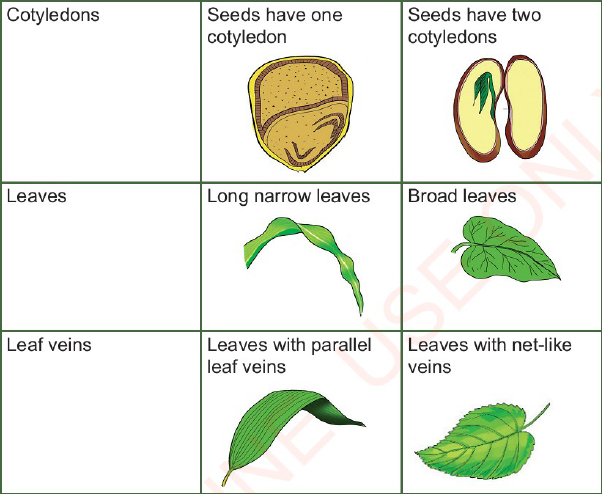 |
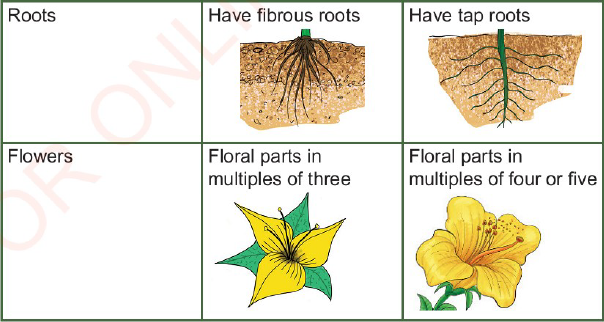 |
Activity 2:
Examining plants and the seeds of monocotyledonous and dicotyledonous plants
Materials:
Bean seeds, groundnuts, sorghum, maize or rice that have started to germinate, a maize plant, a groundnut plant, a bean plant and grass. These plants should have roots.
Procedure
1. Collect the plants listed above.
2. Take the bean and groundnut seeds that have started to germinate.
3. Remove the seed coat, then observe and write what you see.
4. Take the maize, rice and sorghum seeds. Study them and write what you see.
5. Take the bean and groundnut plants. Carefully observe the way the leaves and roots are formed and then write what you see.
6. Take the maize, rice and sorghum plants. Carefully study the structure of their leaves and roots and then write what you see.
7. Classify the plants and seeds into Group A and Group B by following the descriptions below.
Group A
(a) Plants with long leaves and parallel venation
(b) Plants with brushy roots with no main root
(c) Plants whose seeds have one cotyledon
Group B
(a) Plants with broad leaves and net-like venation
(b) Plants with main roots
(c) Plants whose seeds have two cotyledons
Monocotyledonous plants
Monocotyledonous plants have seeds with one cotyledon. The presence of one cotyledon in seeds is the reason such plants are regarded as monocotyledonous. Monocotyledonous plants have leaves with parallel venation. They also have fibrous roots. Fibrous roots are thread-like roots that arise from the base of the stem. They are usually short and numerous with almost the same length and diameter. Examples of monocotyledonous plants are sorghum, maize, finger millet, coconut and wheat.
 Figure 4(a) Seeds of Monocotyledon plants |
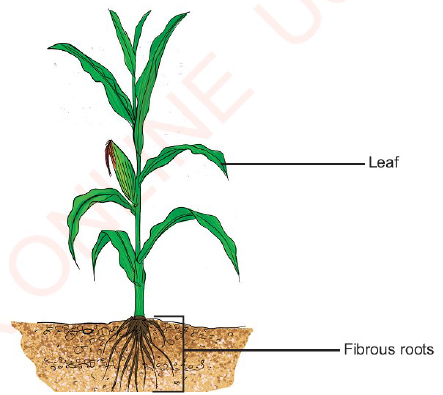 Figure 4(b) Leaves and roots of Monocotyledon plants |
Dicotyledonous plants
Dicotyledonous plants have seeds with two cotyledons or seed leaves. The presence of two cotyledons in seeds is the reason these plants are regarded as dicotyledonous. The term implies two cotyledons or two seed leaves. Examples of dicotyledonous plants are mangoes and leguminous plants such as beans. The leaves of dicotyledonous plants have net-like venation. In addition, these plants have main roots in which smaller roots grow from the main ones.
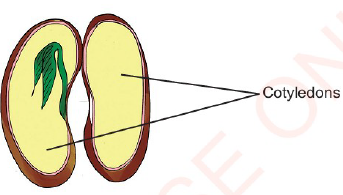 Figure 5(a) Seed of dicotyledons |
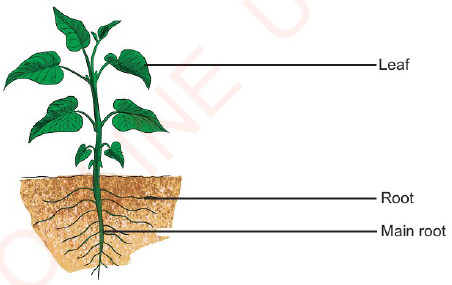 Figure 5(b) Leafs and roots of dicotyledon plant |
| Exercise Answer the following questions. 1 . Name two main groups of plants. 2. Mention four differences between monocotyledonous and dicotyledonous plants. 3. Groundnut and leguminous plants are examples of plants. 4. Maize, sorghum and rice plants are examples of 5. Explain the difference between leguminous and maize plants. |
Non-flowering plants
Non-flowering plants are plants whose reproductive structures are not flowers. Examples include pine and cypress plants. These plants do not produce fruits but produce naked seeds. The seeds of these plants are not covered inside fruits. Most of non-flowering plants have leaves throughout the year. These plants are a good source of firewood and timber. Some non-flowering plants are used to make paper and gum. Non-flowering plants also provide shelter to animals.
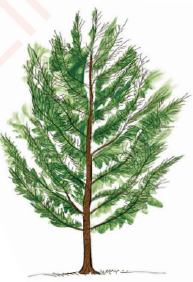 Non-flowering plants |
Activity 3: Identifying different types of plants
Get out of the classroom and then observe different types of plants which are found in the school environment. Try to recall the plants you saw at home or on your way to school. List them. Classify the plants into either flowering or non-flowering plants.
Parts of a plant
A plant has three main parts, which are roots, stems and leaves. Usually, roots of a plant are found below the ground. The stem is also called a trunk. The stem of a plant is found above the ground. Other parts of plants are flowers, fruits and seeds. Each of these parts has different functions which enable plants to grow well.
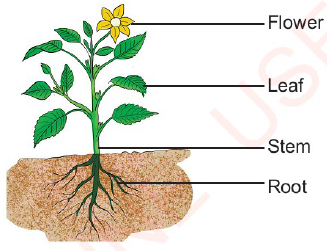 Figure 7: Main parts of a plant |
Roots
The main function of roots is to absorb water, minerals and nutrients from the soil. The other functions of roots are to store food and support a plant in the ground. Examples of plants that store food in their roots are carrots, cassava and sweet potatoes. Roots hold the soil and prevent it from being washed away by water easily.
Stem
The function of the stem is to hold leaves, flowers and fruits. The stem also transports water, minerals and other nutrients from the roots to different parts of a plant. In addition, plants like the sugarcane store food in their stems.
Leaves
One function of leaves is to manufacture food for a plant; hence, they help plants to grow. Most plants have leaves with stomata which can open and close. The opening and closing of stomata helps plants to control the amount of water, oxygen and carbon dioxide which enters or leaves a plant.
Flowers and fruits
The main function of flowers is reproduction. Many flowers have beautiful colours and odour that attract insects. These insects carry pollen from one flower to another. This action is called pollination.
The life cycle of flowering plants
After pollination, a flower develops into a fruit. A fruit may carry one or several seeds. When a seed falls into a suitable environment, it germinates and develops into a new plant. When the plant matures, it produces flowers that produce fruits and seeds. This cycle continues as indicated in Figure 8.
 Figure 8: The life cycle of a tomato plant |
Activity 4:
Examining the main parts of a plant
Materials:
Paper, a maize plant or any other plant which is found in your environment
Procedure
1 . Take the maize plant or any other plant which is found in your environment and put it on a table.
2. Study the parts of the plant.
3. Draw and label the parts of the plant and then answer the following questions:
(a) In which part of the plant are the leaves located?
(b) In which part of the plant are the roots located?
(c) In which part of the plant is the trunk located?
Groups of animals
Like plants, animals are classified into two main groups. The first group includes animals with a vertebral column. They are called vertebrates. The second group includes animals without a vertebral column. They are called invertebrates. Examples of vertebrates are human beings, cows, chickens, ducks, lizards, fish and frogs. Examples of invertebrates include grasshoppers, ants, butterflies, millipedes, snails and worms.
The vertebral column is formed by bones which are arranged one after another at the back of the body. The vertebral column extends from the bottom of the head to the bottom part of the waist or pelvis. For animals with tails, the vertebral column extends to the tail. Within the vertebral column, there is a spinal cord, which is an extension of the brain. The brain and spinal cord make up the central nervous system. The nervous system sends information to different parts of the body through nerves.
Vertebrate animals
Group of animals with a vertebrate column include fish, amphibians, reptiles and mammals
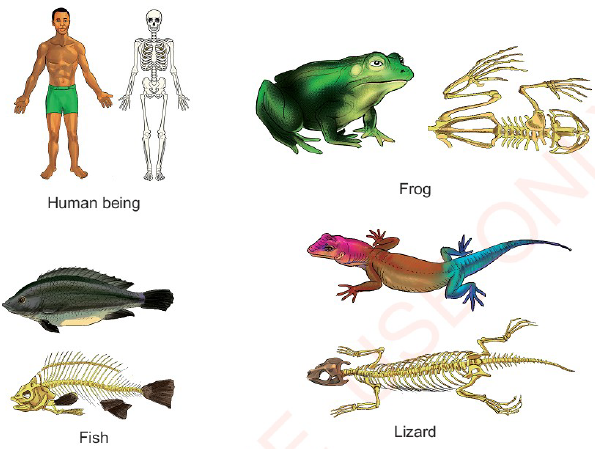 Skeleton and animals with vertebral column |
These groups have specific characteristics that distinguish one group from another group.
Fish
There are different types of fish but all live in water. Some fish live in salt water, for example sharks. Others live in fresh water, for example the Nile Perch and catfish. Some fish have scales, for example tilapia. Others do not have scales, for example catfish. They breathe by using gills. Fish can also be categorized into two sub-groups, those with hard bones such as tilapia and those with cartilage such as sharks.
Activity 5:
Examining the structure of a fish
Materials:
Fresh or frozen fish, a dissecting board and gloves
Procedure
1. Take the fish and put it on the dissecting board.
2. Observe the shape of the head and other body parts of the fish and record what you see.
3. Carefully touch the body of the fish from the tail to the head and write what you feel.
4. Study the back, tail, sides and abdomen of the fish and then record what you have observed.
5. Examine the fins of the fish and count them.
6. Open the operculum and write about what you have seen.
7. Draw a diagram of the fish and label its parts.
Characteristics of fish
1. Fish are cold-blooded animals, since their body temperature varies according to the temperature of the environment.
2. Some fish have bodies which are covered with scales which overlap towards the tail.
3. Fish have fins which help them to swim and change direction.
4. Fish use gills to get oxygen from water. Gills are covered by a hard cover called an operculum.
5. The body of fish is streamlined in order to help them to move smoothly in water.
6. Most fish breed by laying eggs.
7. The body of a fish is covered by some mucus material which reduces resistance when it is swimming.
 Parts of fish |
Exercise
Answer the following questions.
1. Where do fish live?
2. What features enable fish to swim smoothly in water?
3. Explain the functions of gills in the body of a fish.
Amphibians
Most of the animals in this group live in water at the early stages of their development. Examples of the animals found in this group are frogs and toads. Frogs live in water and toads live on land but lay eggs in water. Most frogs lay eggs in fresh water. Eggs hatch into larvae. A larva is also called a tadpole, which lives in water and breathes by using gills. When the tadpole grows in size, legs and lungs develop. At this stage, the frog can live on dry land.
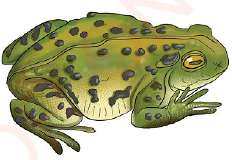 (a) Toad | 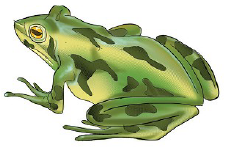 (b) Frog |
| Figure 11 : Toad and Frog | |
Characteristics of amphibians
1. Amphibians have soft and moist skin which is used for gaseous exchange.
2. Amphibians have tympanic membranes on each side of the head just behind the eyes. These are used for hearing.
3. Amphibians have gills during their early stage. Gills help them to breathe. At maturity, they use lungs and skin to breathe.
4. Amphibians are cold-blooded. Their body temperature changes according to the temperature of the environment. This condition is termed as poiklothermic
5. Amphibians have four limbs. The fore limbs are shorter than the hind limbs.
6. Each limb has five digits which are joined together by webs.
7. Most amphibians lay eggs in water, but some amphibians give birth to young ones. An example of an amphibian that gives birth to young ones is the Kihansi toad.
8. Amphibians have a wide mouth which helps them to swallow food very fast and easily.
Activity 6:
Examining the body parts of a toad
Materials:
A toad, gloves, a dissecting board and chloroform
Procedure
1. Wear gloves and then put the toad in a jar containing cotton wool moistened with chloroform. (Caution: Do not inhale the fumes from chloroform).
2. Put the toad on the dissecting board.
3. Study the body to see whether it has a neck or not and write what you see.
4. Observe its mouth and then write what you see.
5. Observe its eyes and then write what you see.
6. Compare the lengths of the fore limbs and the hind limbs. Then write what you see.
7. Study the limbs and digits. What have you noted?
8. Carefully observe the toad behind the eyes. What do you see?
9. Touch its skin and write what you see and feel.
10.Draw a diagram of the toad and show its parts.
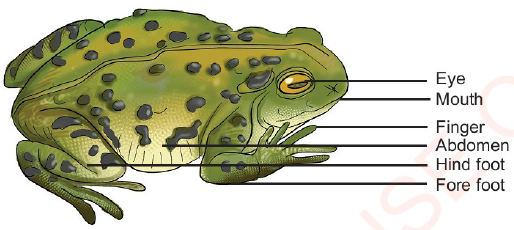 Figure 12: Body parts of a toad |
| Exercise Answer the following questions.1. What is the natural habitat of a toad? 2. Which parts of a toad are used for breathing? 3. Name the structure used for breathing in the larval stage of amphibians. 4. What do you understand by the term cold-blooded animal? |
Reptiles
Most of the members of this group of animals live on dry land and very few live in water. Examples of the reptiles that live on dry land are lizards, snakes, tortoises and chameleons. Examples of the reptiles that live both in water and on land are crocodiles, turtles, some snakes and monitor lizards. Some of the animals in this group such as lizards and monitor lizards have legs. However, some reptiles such as snakes do not have legs and they move by crawling. Most reptiles live and lay their eggs on land. Others such as turtles live in water but lay their eggs on land.
 Figure 13: Examples of reptiles |
| Activity 7: Examining the body parts of a reptile Materials: A lizard, a chloroform, gloves and a dissecting board Procedure 1. Wear the gloves and then put the lizard in a jar containing cotton wool moistened with chloroform. (Caution: Do not inhale the fumes from chloroform). 2. Put the lizard on the dissecting board. 3. Study its body, touch it and then write what you feel. 4. Study its head. What is the shape of the head? 5. Examine its tail. Write what you see. 6. Check behind the eyes. What do you see? 7. Observe its legs. How many legs and digits does it have? 8. What do you see at the tip of the digits? 9. Draw a diagram of the lizard and label its parts. |
Characteristics of reptiles
1. The skin of reptiles is dry and it is covered with scales.
2. Many reptiles have streamlined bodies from the head towards the tail.
3. Their tails are long and thin.
4. Some reptiles, for example snakes, do not have limbs. They move by crawling.
20
5. Some reptiles have limbs with five clawed digits which help them to move.
6. The mouths of reptiles are wide and elongated.
7. Most reptiles lay eggs.
8. The body temperature of reptiles changes with that of the environment. Therefore, they are cold-blooded animals.
9. Reptiles use lungs to breathe.
Exercise 5
Answer the following questions.
1 . Mention the natural habitats of reptiles.
2. List five examples of reptiles.
3. What are the structures used by reptiles to move?
4. (a) Which reptile changes colour?
(b) Why do they change colour?
5. Name the reptiles that live on both dry land and in water.
6. List five characteristics of reptiles.
Birds
Birds are animals with a vertebral column and feathers. Some are domestic birds while others are wild birds. Examples of domestic birds are chickens, ducks, pigeons, guinea fowls and parrots. Examples of wild birds include kites, owls, eagles, pigeons, crows and ostriches. Most birds live on land, but some spend most of their time in water.
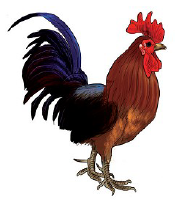 (a) Rooster | 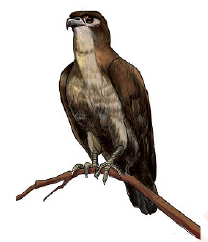 (b) Eagle |
| Examples of birds | |
Activity 8: Examining the body parts of a chicken
Materials:
Alive chicken and a string
Procedure
1. Use the string to tie the legs of the chicken.
2. Examine the chicken's body. What covers the body?
3. Observe the legs of the chicken and write what you see.
4. Count the digits in the chicken's legs. How many digits are there on the legs and what are their functions?
5. Observe the chicken's claws. What do you think are the functions of these claws?
6. Observe the wings of the chicken. How many wings does the chicken have?
7. Examine the beak of the chicken. How does it look?
8. Draw a diagram of the chicken to show its external parts.
Characteristics of birds
1. Birds have a streamlined body shape which helps them to fly with minimum resistance. The middle part of the body is broader than the head and the tail.
2. The body of a bird is covered by feathers which help in insulating the body. The feathers also prevent water from reaching the skin.
3. Birds have wings with long feathers which help them to fly. However, there are birds which do not fly. Examples of birds which do not fly include penguins, ostriches and kiwis.
4. A bird's beak is tough and elongated. Some birds such as flamingos and hornbills have very long beaks, while others such as ducks and doves have very short beaks with sharp ends.
5. All birds have two legs which have scales and each leg has four digits with tough claws.
6. The temperature of the bird's body does not change with that of the environment. This means birds have constant body temperature; thus, they are called warm-blooded animals. This condition is termed as homoeothermic. The average bird's body temperature is 40 degrees centigrade.
7. Birds reproduce by laying eggs.
| Exercise Answer the following questions.1. Mention the natural habitats of birds. 2. Mention the characteristic which enables birds to fly without much resistance. 3. Explain the importance of feathers to birds. 4. Mention the features of a bird's beak. 5. Give the meaning of the term homoeothermic. 6. List three examples of domestic birds. |
Mammals
Mammals constitute one of the groups of animals which have a vertebral column. Most of them reproduce by giving birth to young ones. Their bodies are covered by hairy skin. However, the amount of hair varies, depending on the type of mammal. Most mammals live on land. They use two or four legs to move. Some mammals such as bats can fly. Some mammals such as whales live in water. Examples of mammals are human beings, bats, whales, rats, elephants, dogs, donkeys, lions, horses, zebra, leopards, kangaroos, cows, goats, baboons and sheep.
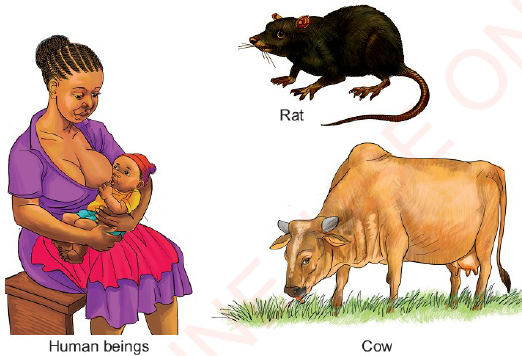 Examples of mammals |
Activity 9:
Examining the body parts of a rat
Materials:
A rat, gloves, a dissecting board and chloroform
Procedure
1 . Wear the gloves and put the rat in a jar containing cotton wool moistened with chloroform. (Caution: Do not inhale the fumes from chloroform).
2. Put the rat on the dissecting board.
3. Study the body of the rat by looking at the head, trunk and tail. What covers the body of the rat?
4. Observe the ears of the rat. How do they look?
5. Open the mouth of the rat. What do you see?
6. Draw a diagram of the rat to show its outer parts.
Characteristics of mammals
1. Mammals feed their young with milk from their mammary glands.
2. Mammals have ears which are visible externally. The ears are large because they are used to pick up sound waves.
3. Their bodies are covered with hairs which conserve heat and maintain body temperature.
4. The skin of the mammals that live on land has sweat glands, which are responsible for producing sweat. The skin of whales does not have sweat glands because this animal lives in water.
5.Most mammals give birth to alive young ones. A few mammals such as echidnas and duck-billed platypuses lay eggs. Others such as kangaroos give birth to immature young which are reared in a special pouch found on their bodies.
6. Except for human beings that move by using two legs, mammals move by using four legs.
7. Most mammals live on land but a few live in water. Examples of mammals which live in water are whales and porpoises.
8. The temperature of the mammalian body does not change with that of the environment. Mammals can maintain a constant body temperature. This is a homoeothermic condition. This condition enables mammals to live in environments with different temperatures.
9. Mammals use lungs to breathe.
Invertebrate animals
In terms of the number of species, this group of animals is larger than the group of animals with a vertebral column. The animals found in this group have no vertebral column. Examples of animals without the vertebral column are arthropods, including grasshoppers, cockroaches, ants, millipedes and butterflies. Other invertebrates include earth worms, snails, squids and octopuses. These animals are found in terrestrial and aquatic habitats. If you do an investigation in your environment you will realize that these animals are found everywhere.
Arthropod is a group of invertebrates with an external skeleton, a segmented body and paired appendages. Examples of the animals found in the arthropod group are crabs, grasshoppers, spiders, scorpions and millipedes. They constitute the largest group of animals. The second group is that of worms. Some groups of worms live in the bodies of other animals such as human beings, dogs and chickens, while others live in water or in the soil. The third group is that of snails and squids. Some of the members of this group live in dry environment while others live in water. Some of the animals in this group live in salt water, for example squids.
|
Figure 16: Invertebrate animals |
Activity 10:
Examining invertebrate animals
Materials:
A rat, gloves, a dissecting board and chloroform
Procedure
1 . Wear the gloves and pick up the dissecting board.
2. Pick up the grasshopper and then put it on the dissecting board.
3. Dissect the grasshopper and study it to see if it has a vertebral column. Write what you see.
4. Do the same for the cockroach and millipede.
Exercise 8
Answer the following questions.
Section A:
Choose the correct answer and then write the answer in your exercise book.
1. . . . . . . . . .fly in the air using wings which have feathers.
- Birds
- Bats
- Mosquitoes
- Butterflies
2. . . . . . . . . . lay eggs in water although they live on land.
- Tortoises
- Turtles
- Toads
- Crocodiles
3. . . . . . . . . . . . live in water but lay their eggs on land.
- Whales
- Tortoises
- Lizards
- Turtles
4.. . . . . . . . . are mammals but do not have sweat glands.
- Sharks
- Whales
- Dogs
- Rats
5. . . . . . . . . . . produce seeds but do not produce flowers.
- Orange trees
- pine trees
- Maize plants
- Mango trees
Section B
6. Match the terms in List A with the correct descriptions in List B.
| List A | List B |
|
|
Section C
7. Write TRUE for a true statement and FALSE for a false statement.
(a) Birds are the only animals which are cold-blooded. . . .. . . .
(b) If the noses of a frog are closed, the frog will die.. .. . . . . . .
(c) The human being and the rat belong to the same animal group. . . . . . . .
(d) A crocodile belongs to the group of mammals. Bats are birds because they fly. . . . . . . .
(f) All birds have feathers. . . . . . . . .
(g) There are certain types of frogs which give birth to alive young ones without laying eggs. . . . . . . . .
(h) All mammals live on dry land. . . . . . . . .
(i) Reptiles and amphibians are cold-blooded animals. . . . . . . . .
(j) Worms and mosquitoes do not have a vertebral column. . . . . . . . . .
Section D:
Answer the following questions.
8. Mention five animals found in the group of mammals.
9. List the characteristics of mammals.
10. Why are bats considered as mammals?
11. The body temperature of mammals does not change with that of the environment. What is this condition called?
12. Mention two mammals which live in water.
13. Animals can be poikilothermic or homoeothermic.
(a) What is the meaning of the word poikilothermic?
(b) What is the meaning of the word homoiothermic?
(c) Give examples of the animals that belong to each group in (a) and (b) above.
14. List four animals that have a vertebral column.
15. List four animals that do not have a vertebral column.
16. Explain the difference between animals with a vertebral column and those without it.
17. Explain the function of the vertebral column.
www.learninghubtz.co.tz
Hub App
 For Call,Sms&WhatsApp: 255769929722 / 255754805256
For Call,Sms&WhatsApp: 255769929722 / 255754805256
 For Call,Sms&WhatsApp: 255769929722 / 255754805256
For Call,Sms&WhatsApp: 255769929722 / 255754805256
WHATSAPP US NOW FOR ANY QUERY
App Ya Learning Hub Tanzania
